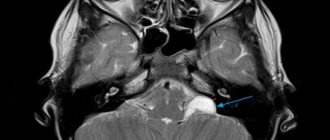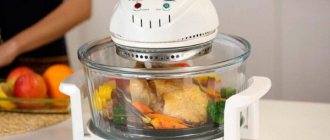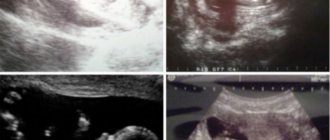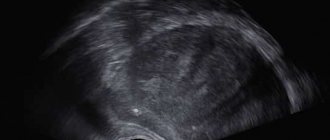One of the first signs of problems in the body is an increase in body temperature. We all know how to measure body temperature, but we don’t always do it correctly. The temperature in the room where the measurement is taking place should be between 18-25 degrees. If the room is cooler, then before placing the thermometer under your armpit, you must first hold it in your hands for about 30-40 seconds, warming it with your palms. Before installing the thermometer, you need to wipe the skin of the armpit with a napkin or dry towel. This will significantly reduce the risk of the thermometer cooling due to sweat evaporation. Don't forget to shake the thermometer if you are using the mercury version, or turn on the electronic one. When installing a thermometer, be sure to make sure that the mercury column (or the metal tip in an electronic thermometer) hits the deepest point of the armpit, and it should be in contact with the body on all sides. The thermometer should not rest against clothing. Air should not enter the armpit. Therefore, press your shoulder and elbow towards your body, then the armpit will be closed. A tight seal to the skin must be ensured throughout the entire measurement period. Do not take your temperature immediately after coming in from outside, exercising, taking a bath or taking a warm shower. Usually, if a person (especially a child) cried or was very nervous, the temperature will be too high. An increased result will be obtained immediately after a hearty lunch rich in protein foods, as well as after drinking hot tea. In all these cases, you need to wait at least 10-15 minutes, which should be spent at rest, and only then start measuring the temperature. During the measurement, you must remain motionless, do not talk, do not sing, do not eat, do not drink. The measurement time for a mercury thermometer is a minimum of 6 minutes, a maximum of 10, and an electronic one must be kept under the arm for another 2-3 minutes after the sound signal. Take out the thermometer in a smooth motion. If you sharply pull out an electronic thermometer, due to friction with the skin, it will add a few more tenths of a degree. When you are sick, measure your temperature at least twice a day - in the morning (between 7-9 hours) and in the evening (between 19 and 21 hours). In this case, it is advisable to set the thermometer at the same time, this is how you can track the dynamics of temperature changes. In case of severe illness accompanied by high temperature, it should be measured before taking antipyretics, as well as after (30-40 minutes after taking the medicine). If several people use the thermometer, do not forget to wipe it with a disinfectant solution and wipe it dry after each use.
Physician-therapist of the department of medical prevention Shaidullina R.F.
Quantity
Features of temperature measurement in newborns and young children.
The author of the article is pediatrician Natalya Viktorovna Krivonozhko Measuring body temperature is one of the ways available to a person to independently obtain objective data about the state of his health. Thermometry is of particular importance for newborns and young children who cannot yet talk about their health. In the first days of life, a healthy newborn experiences instability in body temperature and rapid changes during crying, feeding, and swaddling. Gradually, by 1.5 - 3 months, a temperature curve characteristic of healthy infants is established. A newborn baby is equally susceptible to both hypothermia and overheating, which is undesirable for the child’s body. In our catalog you can find the latest models of children's thermometers. In children, the normal temperature is slightly higher than in adults (by 0.3-0.4′), and the range of daily fluctuations can reach 1.4′. When doing thermometry, it is worth remembering that the temperature of the internal organs and mucous membranes is usually higher than the skin temperature and is approximately 38′ C. Therefore, measuring the temperature in the rectum (rectal temperature) or in the external auditory canal gives higher values. Axillary (armpit) temperature is usually 1′ lower than rectal and 0.5′ lower than oral (measured in the mouth). From the first days of a child’s life, the axillary temperature is set within 36-37′ C (36.6 0.4). The temperature is considered elevated if, when measuring rectal temperature, it exceeds 38′ C, axillary - 37′ C, oral - 37.5′ C. When measuring temperature, measures must be taken to ensure that the child is calm, since movements increase the temperature. Body temperature can rise as a result of severe physical or emotional stress, and also depends on the temperature of the room and the amount of clothing, so it is important that the room maintains a stable temperature and humidity. The normal temperature in the room is considered to be 20-22′ C. You should not cover the child in the room too warmly, or place additional heating devices next to him. Fever is a symptom, not a disease. The reasons for a rise in body temperature are varied. More often, an increase in temperature occurs as a protective reaction , with the help of which the body simultaneously increases its resistance to disease and suppresses the proliferation of pathogenic bacteria - most microbes and viruses are active at a body temperature of about 37′ C, but lose viability at 39′ C. However, high temperatures (above 38'C) can be dangerous for children under 1 year of age (risk of developing fibril seizures). Therefore, pediatricians recommend carefully monitoring temperature fluctuations during ARI in young patients. Thermometers. Mercury thermometers have been used to determine human body temperature for more than 300 years.
The mercury thermometer acquired its modern appearance back in the 18th century and became widespread in everyday life. Axillary measurement using a conventional mercury thermometer is carried out within 7-10 minutes. Not every child is able to behave calmly for such a long time, which does not always give an accurate result. Oral or rectal measurements are considered more accurate, but carrying out such measurements using glass mercury thermometers at home by people who do not have special skills poses a certain danger for young children. Ear thermometers are not always suitable for newborn children in terms of the size of the measuring tip. This is the reason for the growing popularity of digital thermometers all over the world, especially since they are not only convenient and easy to use, but also quite affordable.
They measure temperature very quickly - within a few seconds, and have a flexible tip, which allows you to take rectal and oral measurements without any problems. Its advantages do not stop there - they have an electronic memory that allows you to fill in the time and results of the last few measurements. A sound signal indicates the readiness of the result. Digital thermometers are lightweight and safe, and measuring temperature with their help does not cause discomfort to the child. The most modern thermometer today is even more hygienic and easy to use - an infrared non-contact thermometer that allows you to measure a child’s temperature even while sleeping, without disturbing the baby. Among the new interesting thermometers, we can note the Japanese non-contact thermometer Combi - in order to measure the temperature, you just need to press a button, and with this thermometer you can measure the temperature of objects - a bottle of milk or water in a glass, and it also shows the air temperature in the room. Determines temperature in 0.1 second. The non-contact electronic thermometer from the Dutch manufacturer Brother Max is easy to use - it will determine the temperature from a distance of 2.5 cm in seconds and will also serve as a room thermometer. The Hartmann Thermoval Duo Scan infrared thermometer from Germany instantly and professionally determines the temperature of the most restless child. The B.Well “Duckling” electronic thermometer is quite small, but, unlike a glass mercury thermometer, it is completely safe, lightweight and has many useful functions. PS Thermometers for newborns can be purchased here!
Video
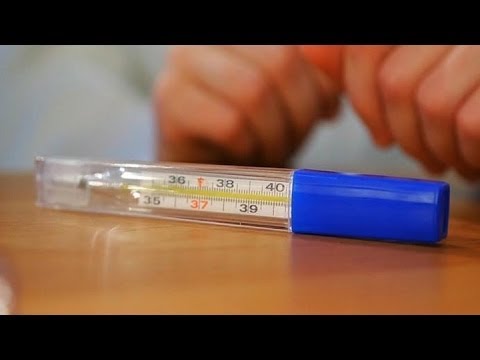
Home first aid kit: how to measure temperature correctly?
Attention! The information presented in the article is for informational purposes only. The materials in the article do not encourage self-treatment. Only a qualified doctor can make a diagnosis and give treatment recommendations based on the individual characteristics of a particular patient.
Accuracy - up to 1.5 degrees
The operating principle of an electronic thermometer differs significantly from the classic mercury thermometer. The indication of temperature in the second occurs due to the increase in the volume of mercury when heated, which by and large makes it unimportant how to hold it. In electronic thermometers, the sensor is located at the end, so only the heating of this part affects the readings. The rest of the thermometer is just wires. It is for this reason that you need to carefully monitor the position of the thermometer to achieve accuracy. If the contact with the body is loose or the sensor is partially free, the temperature will be lower.
The error of an electronic thermometer can be quite large (1.5 degrees), especially if you measured the temperature incorrectly and quickly.
What to do if your child has a high temperature?
If the thermometer shows a high temperature in a child, you should consult a doctor. In addition, you should pay attention to his behavior and possible symptoms. Signs of fever are:
- Sweating;
- Increased heart rate and breathing;
- Excessive blushing or pallor;
- Noticeable chills;
- Sore eyes;
- Dry lips;
- Thirst.
However, a child's temperature may rise if the baby has been crying for a long time, has been overly wrapped up, or suffers from constipation or teething. High mobility and lack of water in the body can also cause an increase in temperature. By the way, it is recommended to measure your temperature at 7-9 am or at 17-19 pm, unless the doctor has given other recommendations.
In any case, if the temperature is higher than normal, you should consult a doctor. But it’s not worth lowering the temperature to 37.3°C, giving the baby antibiotics or other medications that the doctor did not prescribe. If the baby is cheerful and active, does not lose appetite and is not capricious more than usual, there is no need to try to “treat” him. Just remember that a child's normal temperature is different from an adult's, and also check that the room is not too hot and dry.
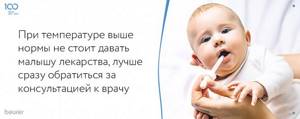
It also happens that the baby’s temperature is normal, but he is lethargic and capricious, refuses to eat, and cries for no apparent reason. It is important to understand that fever is not the only symptom of the disease. Many diseases are not reflected in any way on the thermometer, but this does not mean that you can ignore them. If the child's behavior has changed significantly, it is better to show him to the doctor.
Mercury thermometer
The most accurate device, there is practically no deviation from the temperature measurement, and errors are rare and are calculated in fractions of a degree. Another advantage is the possibility of disinfection. This device can measure the temperature in the armpit, mouth and rectum.
A mercury thermometer has two disadvantages - the duration of measurement and fragility. The thermometer will have to be left in the armpit for 10 minutes, in the mouth and anus for 5 minutes, which causes difficulties when measuring temperature in infants. The thermometer is made of glass, and is filled with the substance mercury, which causes poisoning of the body. Therefore, it is important to be careful when using it, especially in children.
Critical temperature
If the temperature of a victim from overheating increases to an absolute scale level above 42 °C and it is impossible to reduce the indicator, the probability of death is high. There was a recorded case where a patient managed to survive overheating up to 46.5 °C. The lower limit in some cases can reach 25-26 °C. With hyperthermia - an increase in the indicator to 42 ° C and above - loss of consciousness, hallucinations, and delirium are observed. In this case, the patient’s life is in serious danger, so it is necessary to lower this biometric indicator in any available way.





